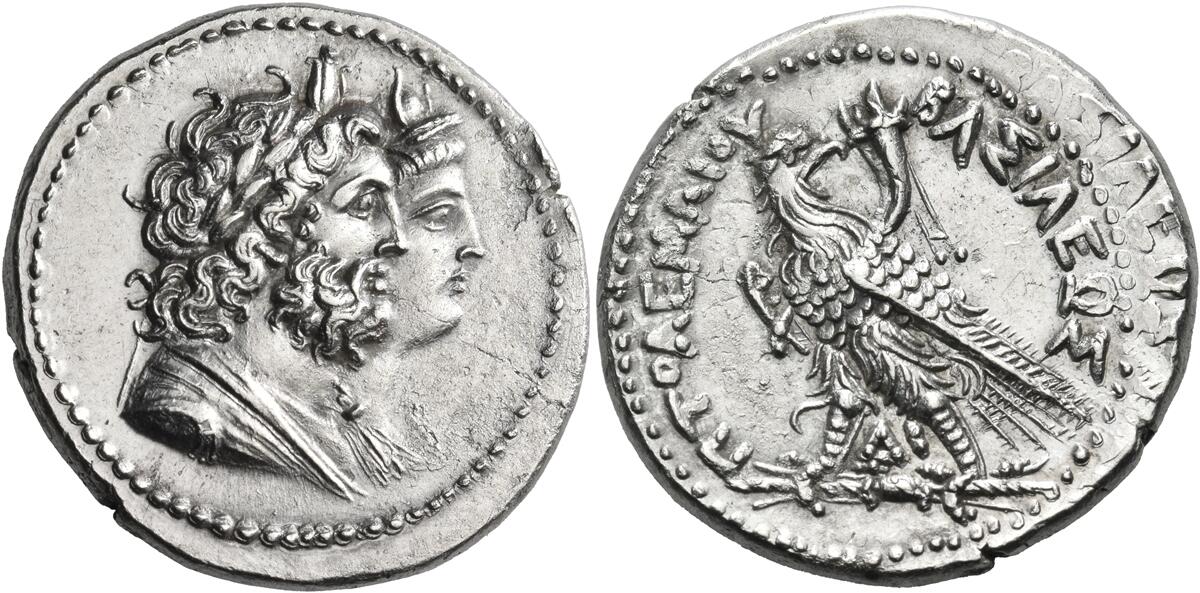S 991 - Alexandria (Ptolemy IV), silver, tetradrachms (219-215 BCE)
From SILVER
219 BCE - 215 BCE Silver 7,199 kg
Description
| ObverseInscription or printing placed on the obverse.: | Jugate busts to right of Serapis, laureate, bearded and draped, and Isis, crowned, diademed and draped |
| ReverseInscription or printing placed on the reverse.: | ΒΑΣΙΛΕΩΣ ΠΤΟΛΕΜΑΙΟΥ (Greek).Eagle with closed wings standing on thunderbolt to left, his head turned back to right, with cornucopiae at his shoulder, between eagle's legs, ΔΙ |
Mint and issuing power
| MintIdentifies the place of manufacture or issue of a numismatic object.: | Alexandria | Ancient regionAncient region.: | Egypt | Modern countryModern country: Egypt | AuthorityIdentifies the issuing power. The authority can be "pretended" when the name or the portrait of X is on the coin but he/she was not the issuing power. It can also be "uncertain" when there is no mention of X on the coin but he/she was the issuing power according to the historical sources: | Ptolemaic dynasty (323-30 BC), Ptolemy IV Philopator (Ptolemaic king, 221-205 BC) |
Chronology
| FromIdentifies the initial date in a range assigned in a numismatic context. | 219 BCE | toIdentifies the final date in a range assigned in a numismatic context.. | 215 BCE | PeriodTime period of the numismatic object.: Hellenistic 323-30 BC |
Physical description
| MetalThe physical material (usually metal) from which an object is made.: | Silver |
Median weightMedian of the weights of numismatic objects (in grams). in grams | 14.20 | DenominationTerm indicating the value of a numismatic object. Examples: tetradrachm, chalkous, denarius.: | tetradrachm |
StandardStandard.: | Ptolemaic |
Image

S991 Alexandria Ptolemy IV Landvatter.jpg [1]
References
| Die study referencePublication of the study: | Landvatter 20121Landvatter 2012, p. 63-72 (Groups 1-5) | ||
| Coin series referenceReference to coin series study: | CPE I2CPE I, n° 892 | ||
Obverse dies distribution
| FrequencyFrequency of specimen in distribution. ᵖ | Number of obversesNumber of obverse dies. ᵖ (o) | % (o) | Number of coinsNumber of coins. (n) | % (n) | Die nameName(s) of the die(s). |
| 1 | 3 | 13.04 | 3 | 2.5 | 14, 21, 22 |
| 2 | 4 | 17.39 | 8 | 6.67 | 6, 11, 16, 20 |
| 3 | 5 | 21.74 | 15 | 12.5 | 2, 5, 13, 15, 18 |
| 4 | 2 | 8.7 | 8 | 6.67 | 8, 23 |
| 5 | 1 | 4.35 | 5 | 4.17 | 17 |
| 6 | 3 | 13.04 | 18 | 15 | 1, 7, 9 |
| 7 | 1 | 4.35 | 7 | 5.83 | 19 |
| 10 | 1 | 4.35 | 10 | 8.33 | 3 |
| 14 | 1 | 4.35 | 14 | 11.67 | 10 |
| 15 | 1 | 4.35 | 15 | 12.5 | 4 |
| 17 | 1 | 4.35 | 17 | 14.17 | 12 |
| Total | 23 of 23 | 100.01 | 120 of 120 | 100.01 |
Reverse dies distribution
no distribution is available
Quantification
| Number of obversesNumber of obverse dies. ᵖ (o) | 23 | Number of singletons (o1)The number of singleton coins. ᵖ | 3 |
| Number of reverse diesNumber of reverse dies. (r) | 65 | Number of coinsNumber of coins. (n) | 120 |
| Coins per obverse dieNumber of coins per obverse die. (n/o) | 5.22 | Coins per reverse dieNumber of coins per reverse die. (n/r) | 1.85 |
| Reverse per obverse ratioRatio of obverse dies divided by reverse dies. (r/o) | 2.83 | Percentage of singletons (o1)number of coins (n) divided by the number of singletons (o1) ᵖ | 13.04 % |
| Original number of dies (O) (Carter 1983 formula)The estimation of the number of coins according to Carter 1983 ᵖ | 25.35 | Coins struck if 20,000 as average productivity per dieCoins made if the average productivity for obverses (according to Carter) is 20,000. ᵖ | 507,000 |
| Original number of dies (O) (Esty 2011 formula)The estimation of the number of coins according to the singleton formula in Esty 2011 ᵖ (O) | 28.45 | Survival rate if 20,000 as average productivity per dieSurvival rate if average productivity is 20,000. ᵖ | 0.00024 |
| Coverage (o = % of O) (Esty 1984 formula)Esty 1984 - coverage (% of O) ᵖ (o = % of O) | 97.5% | Die productivity if survival rate 1/2,000Average productivity if survival rate is 1/2,000. ᵖ | 9,467.46 |
| Weight of silver (in kg) if 20,000 coins per die (O = Carter formula)Carter 1983 * Median weight * 20000 (*10 if gold or electrum) ᵖ | 7,199 kg <br /> 7,199 kg | Die productivity if survival rate 1/5,000Average productivity if survival rate is 1/5,000. ᵖ | 23,668.64 |
Remarks